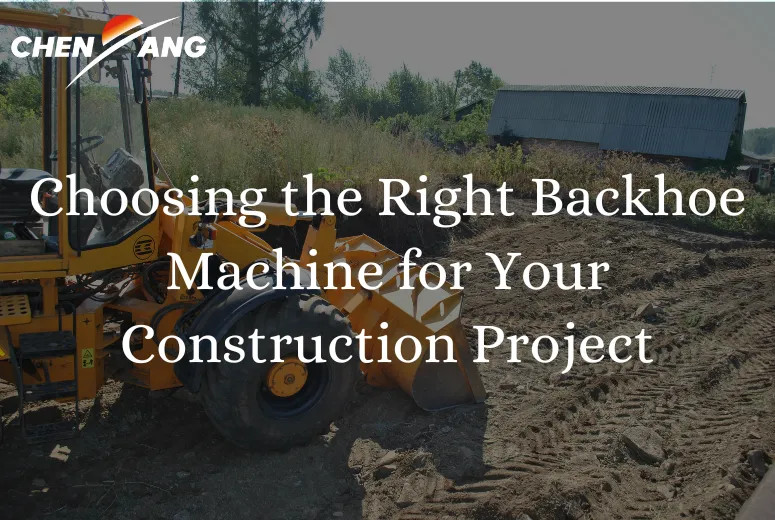Choosing the Right Backhoe Machine for Your Construction Project
When selecting the right backhoe machine for a construction project, it’s important to consider various factors that will directly impact productivity, efficiency, and cost-effectiveness. Backhoes are versatile machines that can handle digging, lifting, and material handling, making them indispensable for many construction tasks. However, choosing the right model requires understanding the specific needs of your project, the terrain, and the job requirements. Here’s a comprehensive guide to help you make an informed decision.

Understand Your Project’s Requirements About Backhoe Machine
Before you begin evaluating backhoe machines, take a step back and assess the unique demands of your construction project. Are you dealing with a small site or a large, expansive area? Will your project require deep digging or just surface-level trenching? The type of work you’re doing will dictate the type of backhoe machine that is best suited for your needs.
For example, if you need to dig deep trenches or perform heavy-duty lifting, a larger backhoe with a high lifting capacity and extended digging depth would be ideal. On the other hand, for smaller, more confined spaces or light excavation, a compact backhoe or a mini backhoe would be more appropriate. Assessing the scale and type of tasks will give you a clearer idea of which machine meets your needs.
Machine Size and Digging Reach of Backhoe Machine
Back loader machine come in various sizes, from compact models to full-sized loaders, each with different digging reach and lifting capacities. A crucial factor to consider is the machine’s digging depth and the reach of its boom arm. If your project involves digging trenches that are several feet deep or requires the machine to reach over obstacles, you’ll want a backhoe with a longer boom and a deeper digging capacity.
Smaller backhoes, while more maneuverable, have limited reach and digging depth, making them better suited for less demanding tasks. If your construction site is in a confined space with restricted movement, these smaller models may be a better fit due to their compact size and agility. However, for projects that require significant digging depth, a larger backhoe with an extended reach would be necessary.
Terrain and Accessibility of Backhoe Machine
The terrain and accessibility of your construction site play a significant role in determining the best backhoe for the job. Rough, uneven, or rocky terrain may require a more powerful and stable machine that can handle challenges such as slopes, mud, or debris. In such cases, a backhoe with all-terrain capabilities, such as four-wheel drive, would provide better stability and traction, allowing it to work effectively in difficult conditions.
For flat, even terrain, standard backhoes will suffice. However, it’s important to consider the ground pressure and weight of the machine to avoid damaging sensitive surfaces like pavement or landscaped areas. If the project involves working on delicate ground, consider machines with adjustable track widths or rubber tires to minimize surface impact.
Power and Engine Performance About Backhoe Machine
The power of the backhoe machine’s engine is an important consideration when evaluating its performance. Larger projects, particularly those involving heavy lifting or deep digging, require a backhoe with a higher horsepower engine to ensure optimal performance and productivity. A powerful engine will also reduce the strain on the machine when working with tough materials like rock or clay.
In contrast, smaller projects that involve light digging or lifting may not require the same level of engine power. If you’re working with soft soil or lighter materials, a machine with a moderate engine size may be more cost-effective and fuel-efficient. Additionally, consider the fuel type and efficiency of the engine, as this can have a significant impact on the overall operating costs of the machine.
Budget and Long-Term Costs of Backhoe Machine
Budget is a key factor when choosing any construction equipment, and backhoes are no exception. The upfront cost of the machine should be weighed against the long-term operating and maintenance costs. A more expensive backhoe may offer superior performance and longer service life, but if your project is relatively short-term, you might want to explore rental options instead of purchasing a machine.
In addition to the initial cost, consider ongoing expenses such as fuel consumption, maintenance, and repair costs. Larger backhoes typically have higher fuel consumption and maintenance requirements, which can add up over time. On the other hand, smaller backhoes or compact machines are often more fuel-efficient and easier to maintain, making them a more economical choice for smaller projects.
Operator Skill and Comfort of Backhoe Machine
Choosing the right backhoe and bulldozer also involves considering the skill level and comfort of the operators. Some models are designed with advanced technology, such as hydraulic systems, GPS guidance, and ergonomic cabins, which can improve operator efficiency and comfort. These features can reduce fatigue, improve accuracy, and increase productivity, especially for operators who will be working long hours.
Additionally, backhoe machines vary in terms of ease of operation. Some models are equipped with user-friendly controls, while others may require a higher level of expertise to operate efficiently. It’s important to consider the skill set of your operators and the ease with which they can handle the machine. Machines with intuitive controls or automatic functions can make the job easier for less experienced operators, while more experienced workers may be able to handle more complex systems.
-
Low Maintenance + High Availability of Ownership for Mining Dump TruckNewsJul.17,2025
-
Drum Drive Axle + Air Suspension for Electric Tractor TruckNewsJul.17,2025
-
33m Boom + Full Hydraulic Outriggers: Narrow-Site Construction Practices of Mixer Pump TruckNewsJul.17,2025
-
18L Large Drum + Extended Drain Interval of Gear Oil for Heavy Duty TrucksNewsJul.17,2025
-
13m Cargo Space + Polyurethane Insulation: Long-Term Cold Chain Protection Solutions for Refrigerated Semi-Trailers for SaleNewsJul.17,2025
-
10T Water Tank + 2.5MPa Fire Pump Efficiency Analysis of Water Tank Fire TruckNewsJul.17,2025
Popular products

























